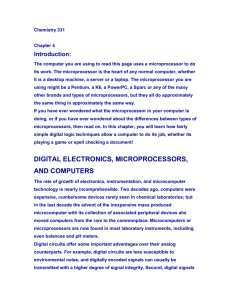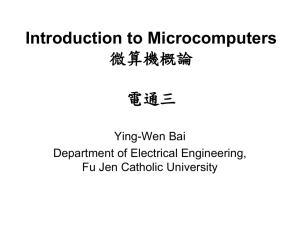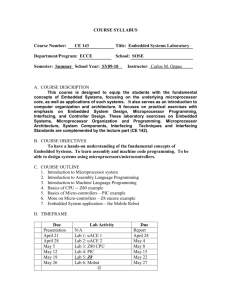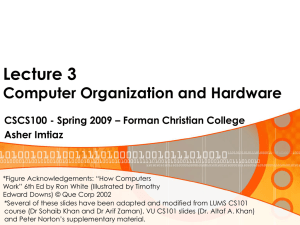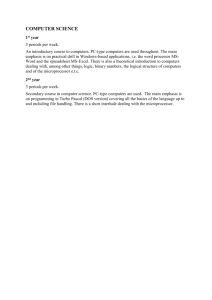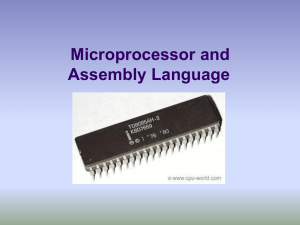MICROPROCESSORS I-INTRODUCTION: Microprocessors are
advertisement
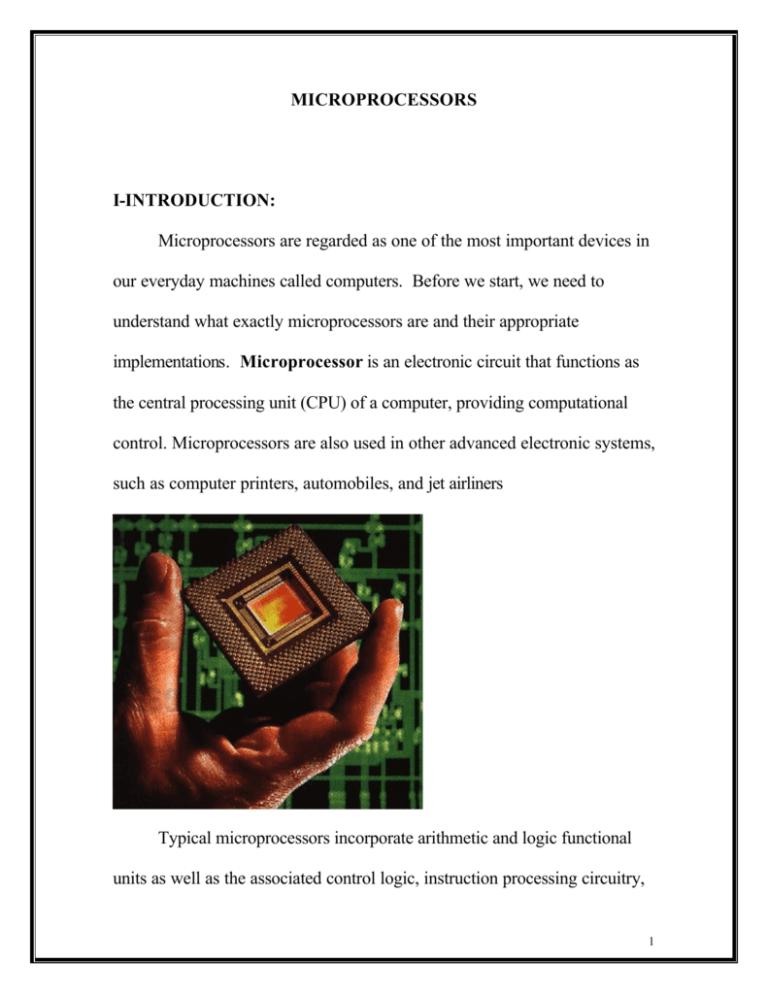
MICROPROCESSORS I-INTRODUCTION: Microprocessors are regarded as one of the most important devices in our everyday machines called computers. Before we start, we need to understand what exactly microprocessors are and their appropriate implementations. Microprocessor is an electronic circuit that functions as the central processing unit (CPU) of a computer, providing computational control. Microprocessors are also used in other advanced electronic systems, such as computer printers, automobiles, and jet airliners Typical microprocessors incorporate arithmetic and logic functional units as well as the associated control logic, instruction processing circuitry, 1 and a portion of the memory hierarchy. Portions of the interface logic for the input/output (I/O) and memory subsystems may also be infused, allowing cheaper overall systems. While many microprocessors and singlechip designs, some high-performance designs rely on a few chips to provide multiple functional units and relatively large caches. (Really, Mark, p. 49) When combined with other integrated circuits that provide storage for data and programs, often on a single semiconductor base to form a chip, the microprocessor becomes the heart of a small computer, or microcomputer. Microprocessors are classified by the semiconductor technology of their design (TTL, transistor-transistor logic; CMOS, complementary-metal-oxide semiconductor; or ECL, emitter-coupled logic), by the width of the data format (4-bit, 8-bit, 16-bit, 32-bit, or 64-bit) they process; and by their instruction set (CISC, complex-instruction-set computer, or RISC, reducedinstruction-set computer; see RISC processor). TTL technology is most commonly used, while CMOS is favored for portable computers and other battery-powered devices because of its low power consumption. ECL is used where the need for its greater speed offsets the fact that it consumes the most power. Four-bit devices, while inexpensive, are good only for simple control applications; in general, the wider the data format, the faster and more expensive the device. CISC processors, which have 70 to several hundred 2 instructions, are easier to program than RISC processors, but are slower and more expensive. (Slater, p. 101-113). Microprocessors have been described in many different ways. They have been compared with the brain and the heart of humans. Their operation has been likened to a switched board, and to the nervous system in an animal. They have often been called microcomputers. The original purpose of the microprocessor was to control memory. That is what they were originally designed to do, and that is what they do today. Specifically, a microprocessor is “a component that implements memory.”(Wilson, p.2430) A microprocessor can do any information-processing task that can be expressed, precisely, as a plan. It is totally uncommitted as to what its plan will be. It is a truly general-purpose information-processing device. The plan, which it is to execute—which will, in other words, control its operation—is stored electronically. This is the principle of “stored program control”. Without a program the microprocessor can do nothing. With one, it can do anything. Furthermore, microprocessors can only perform information-processing tasks. To take action on the outside world, or to receive signals from it, a connection must be provided between the 3 microprocessor’s representation of information (as digital electronic signals) and the real world representation. Developed during the 1970s, the microprocessor became most visible as the central processor of the personal computer. Microprocessors also play supporting roles within larger computers as smart controllers for graphics displays, storage devices, and high-speed printers. However, the vast majority of microprocessors are used to control everything from consumer appliances to smart weapons. The microprocessor has made possible the inexpensive hand-held electronic calculator, the digital wristwatch, and the electronic game. Microprocessors are used to control consumer electronic devices, such as the programmable microwave oven and videocassette recorder; to regulate gasoline consumption and antilock brakes in automobiles; to monitor alarm systems; and to operate automatic tracking and targeting systems in aircraft, tanks, and missiles and to control radar arrays that track and identify aircraft, among other defense applications. (Ismail, and Rooney, p.5-19) HISTORY: 4 The first digital computers were built in the 1940’s using bulky relay and vacuum-tube switches. Relays had mechanical speed limitations. Vacuum tubes required considerable power, dissipated a significant amount of heat, and suffered high failure rates. Some systems achieved processing rates up to 1,000 operations per second. In 1947, Bell Laboratories invented the transistor, which rapidly replaced the vacuum tube as a computer switch for several reasons, including smaller size, faster switching speeds, lower power consumption and dissipation, and higher reliability. In the 1960s Texas Instruments invented the integrated circuit, allowing a single silicon chip to contain several transistors as well as their interconnections. (White, p. 50) The first microprocessor was the Intel 4004, produced in 1971. Originally developed for a calculator, and revolutionary for its time, it contained 2,300 transistors on a 4-bit microprocessor that could perform only 60,000 operations per second. The first 8-bit microprocessor was the Intel 8008, developed in 1972 to run computer terminals. The Intel 8008 contained 3,300 transistors. The first truly general-purpose microprocessor, developed in 1974, was the 8-bit Intel 8080, which contained 4,500 transistors and could execute 200,000 instructions per second. By 1989, 32bit microprocessors containing 1.2 million transistors and capable of 5 executing 20 million instructions per second had been introduced. (Bernstein, p.30) Reductions in both device size and power dissipation are essential in achieving these high densities. Smaller device sizes also allow faster switching speeds, which in turn permit higher processor clock rates. Increased density also lets designers add circuitry to increase the amount of work performed within a cycle. On many benchmarks, high-end microprocessors are two orders of magnitude faster than the DEC VAX11/780 minicomputer, a performance standard in the 1970’s. Key distinctions between mainframe and high-performance microprocessorbased systems often are simply physical size, ability to handle large amounts of I/O, and software issues. (Patterson, p. 15-45) COMPUTER MEMORY: Because the microprocessor alone cannot accommodate the large amount of memory required to store program instructions and data, such as the text in a word-processing program, transistors can be used as memory elements in combination with the microprocessor. Separate integrated circuits, called random-access memory (RAM) chips, which contain large numbers of transistors, are used in conjunction with the microprocessor to 6 provide the needed memory. There are different kinds of random-access memory. Static RAM (SRAM) holds information as long as power is turned on and is usually used as cache memory because it operates very quickly. Another type of memory, dynamic RAM (DRAM), is slower than SRAM and must be periodically refreshed with electricity or the information it holds is lost. DRAM is more economical than SRAM and serves as the main memory element in most computers.(Tocci, p.170) MICROPROCESSOR DESIGN AND ARCHITECTURE: Microprocessors are fabricated using techniques similar to those used for other integrated circuits, such as memory chips. Microprocessors generally have a more complex structure than do other chips, and their manufacture requires extremely precise techniques. The first step in producing a microprocessor is the creation of an ultra pure silicon substrate, a silicon slice in the shape of a round wafer that is polished to a mirror-like smoothness. At present, the largest wafers used in industry are 300 mm (12 in) in diameter. (Tocci, p .170) Economical manufacturing of microprocessors requires mass production. Several hundred dies, or circuit patterns, are created on the surface of a silicon wafer simultaneously. Microprocessors are constructed 7 by a process of deposition and removal of conducting, insulating, and semi conducting materials one thin layer at a time until, after hundreds of separate steps, a complex sandwich is constructed that contains all the interconnected circuitry of the microprocessor. Only the outer surface of the silicon wafer— a layer about 10 microns (about 0.01 mm/0.0004 in) thick, or about onetenth the thickness of a human hair—is used for the electronic circuit. The processing steps include substrate creation, oxidation, lithography, etching, ion implantation, and film deposition.(Tocci, p.172-175) In the oxidation step, an electrically no conducting layer, called a dielectric, is placed between each conductive layer on the wafer. The most important type of dielectric is silicon dioxide, which is “grown” by exposing the silicon wafer to oxygen in a furnace at about 1000°C (about 1800°F). The oxygen combines with the silicon to form a thin layer of oxide about 75 angstroms deep (an angstrom is one ten-billionth of a meter). Nearly every layer that is deposited on the wafer must be patterned accurately into the shape of the transistors and other electronic elements. Usually this is done in a process known as photolithography, which is analogous to transforming the wafer into a piece of photographic film and projecting a picture of the circuit on it. A coating on the surface of the wafer, called the photo resist or resist, changes when exposed to light, making it easy to dissolve in a 8 developing solution. These patterns are as small as 0.13 microns in size. Because the shortest wavelength of visible light is about 0.5 microns, shortwavelength ultraviolet light must be used to resolve the tiny details of the patterns. After photolithography, the wafer is etched—that is, the resist is removed from the wafer either by chemicals, in a process known as wet etching, or by exposure to a corrosive gas, in a special vacuum chamber (Bernstein, p.30-44) In the next step of the process, ion implantation, also called doping, impurities such as boron and phosphorus are introduced into the silicon to alter its conductivity. This is accomplished by ionizing the boron or phosphorus atoms and propelling them at the wafer with an ion implanter at very high energies. The ions become embedded in the surface of the wafer. The thin layers used to build up a microprocessor are referred to as films. In the final step of the process, the films are deposited using sputterers in which thin films are grown in a plasma; by means of evaporation, whereby the material is melted and then evaporated coating the wafer; or by means of chemical-vapor deposition, whereby the material condenses from a gas at low or atmospheric pressure. In each case, the film must be of high purity and its thickness must be controlled within a small fraction of a micron. Microprocessor features are so small and precise that a single speck of dust 9 can destroy an entire die. The rooms used for microprocessor creation are called clean rooms because the air in them is extremely well filtered and virtually free of dust. The purest of today's clean rooms are referred to, as class 1, indicating that there is no more than one speck of dust per cubic foot of air. (Bernstein, p.30-44 ) A basic difference between a microprocessor and other logic chips is the functional flexibility afforded by the microprocessor’s programmable nature. Its instruction set comprises the group of available low-level operations. Each instruction has a specific binary pattern, or operation code. This operation code specifies the operation as well as the location of the operands. A programmer uses sequences of these low-level instructions to create a desired higher-level function. Therefore the personality of a microprocessor-based system can be readily modified without the hardware modifications usually associated with non-programmable logic systems. (Hammerstrom, p. 3 ) A typical microprocessor chip set includes an instruction control unit, one or more functional units, a set of register, and one or more caches. Conceptually, the instruction control unit fetches an instruction from main memory, interprets the operation code, and then dispatches the instruction to a functional unite. The functional unit may again interpret the operation 10 code, read the required operands from the register or memory perform the specified operation and store the result in either the register set or memory. Then the process repeats, with the instruction control unite fetching the next instruction. A powerful aspect of programmability arises from the ability to specify which instruction will be executed next; selection is often based on the outcome of a test involving computed results. (Really, Mark, p.49) For performance reasons, implementations commonly segment the instruction processing into stages and allow multiple instructions to overlap, each executing in a different pipeline stage. High-end designs dispatch multiple instructions each processor cycle. Since main memory access times are relatively slow, smaller, faster memory units are frequently employed to cache recently used portions of main memory, creating a memory hierarchy. These caches are typically an order of magnitude faster than main memory. Separate caches may be used for instruction and data, or a unified cache may hold both. Multiple levels of cache are how a popular solution to the performance problems created by the increasing gap between processor and memory speeds. (Really, Mark , p. 50) CLASSIFICATION OF MICROPROCESSORS: 11 Several functional classifications can be used to classify microprocessors. The different types of microprocessors used most frequently are as follows: INTEL MICROPROCESSORS: 4004 (1970) Intel's Ted Hoff and Federico Faggin designed and implemented (respectively) the first general-purpose microprocessor. The 4004 processor, used in a hand-held calculator built by Busicom of Japan, was part of a fourchip set called the 4000 Family: • 4001 - 2,048-bit ROM memory • 4002 - 320-bit RAM memory • 4003 - 10-bit I/O shift register • 4004 - 4-bit central processor 8008 (1972) The 8008 increased the 4004's word length from four to eight bits, and doubled the volume of information that could be processed. It was still an invention in search of a market however, as the technology world was just beginning to view the microprocessor as a solution to many needs. 12 8080 (1974) The 8080 were 20 times as fast as the 4004 and contained twice as many transistors. This 8-bit chip represented a technological milestone as engineers recognized its value and used it in a wide variety of products. It was perhaps most notable as the processor in the first kit computer, the Altair, which ignited the personal computing phenomenon. 8088 (1979) Created as a cheaper version of Intel's 8086, the 8088 was a 16-bit processor with an 8-bit external bus. This chip became the most ubiquitous in the computer industry when IBM chose it for its first PC. The success of the IBM PC and its clones gave Intel a dominant position in the semiconductor industry. 80286 (1982) With 16 MB of addressable memory and 1 GB of virtual memory, this 16-bit chip is referred to as the first "modern" microprocessor. Many novices were introduced to desktop computing with a "286 machine" and it became the dominant chip of its time. It contained 130,000 transistors and packed serious compute power (12 MHz) into a tiny footprint. 13 80386 (1985), 80486 (1989) The price/performance curve continued its steep climb with the 386 and later the 486 --32-bit processors that brought real computing to the masses. The 386, which became the best-selling microprocessor in history, featured 275,000 transistors; the 486 had more than a million. Pentium¨ (1993) Adding systems-level characteristics to enormous raw compute power, the Pentium supports demanding I/O, graphics and communicationsintensive applications with more than 3 million transistors. Pentium¨ Pro (1995) The newest Pentium has dynamic instruction execution and other performance-enhancing features such as a large L2 cache in the chip package, in addition to its more than 5.5 million transistors. Pentium¨ II (1997) The 7.5 million-transistor Pentium II processor incorporates Intel MMXTM technology, which is designed specifically to process video, audio and graphics data efficiently. Pentium II Xeon (1998) The Pentium II Xeon processors are designed to meet the performance requirements of mid-range and higher servers and workstations. Consistent with Intel's strategy to deliver unique processor products targeted for 14 specific markets segments, the Pentium II Xeon processors feature technical innovations specifically designed for workstations and servers that utilize demanding business applications such as Internet services, corporate data warehousing, digital content creation, and electronic and mechanical design automation. Systems based on the processor can be configured to scale to four or eight processors and beyond . Celeron (1999) Continuing Intel's strategy of developing processors for specific market segments, the Intel Celeron processor is designed for the value PC market segment. It provides consumers great performance at an exceptional value, and it delivers excellent performance for uses such as gaming and educational software Pentium III (1999) The Pentium III processor features 70 new instructions. It was designed to significantly enhance Internet experiences, allowing users to do such things as browse through realistic online museums and stores and download high-quality video. The processor incorporates 9.5 million transistors, and was introduced using 0.25-micron technology. Pentium III Xeon (1999) 15 The Pentium III Xeon processor extends Intel's offerings to the workstation and server market segments, providing additional performance for e-Commerce applications and advanced business computing. The processors incorporate the Pentium III processor's 70 SIMD instructions, which enhance multimedia and streaming video applications. The Pentium III Xeon processor's advance cache technology speeds information from the system bus to the processor, significantly boosting performance. It is designed for systems with multiprocessor configurations. (Brain , Marshall) The Intel family of Processors Chip Year added Data Bus width (in bits) 8 8080 1974 8086 1978 16 8088 1979 80286 Address Bus width (in bits) 8 Speed (in MHz) Transistors 2 6.000 20 5-10 29.000 8 20 4.77 29.000 1982 16 24 8-12 134.000 386DX 1985 32 32 16-33 275.000 386SX 1988 32 24 16-20 275.000 486DX 1989 32 32 25-50 1.2 million 486SX 1991 32 32 16-33 1.185million 487SX 1991 32 32 16-33 1.2 million 486DX2 1991 32 32 33-66 2.0 million 486DX4 1992 32 32 75-100 2.5 million 16 Pentium 1993 32 32 60-166 3.3 million Pentium Pro Pentium II 1995 64 32 150-200 5.5 million 1997 64 64 233-300 7.5 million Pentium II Xeon Celeron 1998 64 64 400-600 7.5 million 1999 64 64 400-600 7.5 million Pentium III Pentium III Xeon 1999 64 64 350-1000 9.5 million 1999 64 64 350-1000 9.5 million (Groth, and Newland, p . 80-81) 4-BIT MICROPROCESSORS: Historically, the 4-bit microprocessor was the first generalpurpose microprocessor introduced on the market. The basic design of the early microprocessors was derived from that of the desk calculator. The Intel 4004, a 4-bit design, was the grandfather of microprocessors. Introduced in late 1971, the 4004 was originally designed for a Japanese manufacturer as the processing element of a desk calculator; it was not designed as a general-purpose computer. The shortcomings of the 4004 were recognized as soon as it was introduced. But it was the first generalpurpose computing device on a chip to be placed on the market. Many of the chips introduced at about the same time by other companies were, in fact, mere calculator chips. Some of them were even serial-by-bit devices, 17 which performed calculations a single bit at a time. The Intel 4004 chip took the integrated circuit down one step further by placing all the parts that made a computer think (i.e. central processing unit, memory, input and output controls) on one small chip. Programming intelligence into inanimate objects had now become possible. (Bernstein, p. 201) The 4004 was the world's first universal microprocessor. In the late 1960s, many scientists had discussed the possibility of a computer on a chip, but nearly everyone felt that integrated circuit technology was not yet ready to support such a chip. Intel's Ted Hoff felt differently; he was the first person to recognize that the new silicon-gated MOS technology might make a single-chip CPU (central processing unit) possible. (Zaks, p. 305-310) Hoff and the Intel team developed such architecture with just over 2,300 transistors in an area of only 3 by 4 millimeters. With its 4 -bit CPU, command register, decoder, decoding control, control monitoring of machine commands and interim register, the 4004 was one heck of a little invention. Today's 64-bit microprocessors are still based on similar designs, and the microprocessor is still the most complex mass-produced product ever with more than 5.5 million 18 transistors performing hundreds of millions of calculations each second - numbers that are sure to be outdated fast. . (Zaks, p. 305-310) Within a short period of time, the 4004 became obsolete and was replaced by the 4040. Then, the powerful 8-bit microprocessors were introduced at a price that was only slightly higher than the price of the 4040. Although 4-bit microprocessors played an important role in the early years of the microcomputer revolution, today they are technically obsolete. Because of their extremely low cost, however, they still offer an attractive alternative to low-end- 8-bit microprocessors. In fact, several 4-bit chips continue to be among the best sellers of all microprocessors: prime examples are the National Semiconductor COP400 and the NEC uPD75XX series. (Bernstein, p.202) 8-BIT MICROPROCESSORS: Today, 8-bit microprocessors coexist with 16-bit microprocessors as the design standard. Although 16-bit chips provide higher performance computationally, 8-bit designs have more than adequate power for many applications—plus the advantage of lower cost. As originally design, most 16-bit microprocessors were limited to packages with a maximum of 40 to 19 48 pins. This was not due to physical, but rather to economic, constraints: industrial tester of the time was generally limited to 40-pin DIPs. The ancestor of today’s 8-bit microprocessors was the Intel 8008, introduced in 1972-1973. The 8008 was not intended to be a general-purpose microprocessor. IT was to be a CRT display controller for Data point. Taking into account all of its design inadequacies and its limited performance, the 8008 was an overwhelming success. (Bernstein, p.202) INTEL (8-BIT MICROPROCESSORS) : The 8080, designed as a successor to Intel’s 8008, was the first powerful microprocessor introduced on the market. Several other microprocessors of similar performance were introduced on the market within a year after the 8080 appeared, and several additional powerful designs were introduced later. Technically, however, the 8080 long remained the most powerful product on the market. Furthermore, Intel was the first company to invest in the development of support chips and software for its products. This ensured the continued success of the 8080 because its performance was then sufficient for many applications. The early 8080 competitors were introduced with at least a nine-month delay and failed to dislodge it. The 8080 is still sold today thought It has been largely eclipsed by successor products—most notably the 8085 microprocessor. Today, the 20 8085 accounts for roughly one of every four 8-bit microprocessors sold. (Bernstein, p. 206) MOTORALA (8-BIT MICROPROCESSORS): The 6800 was introduced by Motorola as a direct competitor to the 8080. The design of the 6800 was obviously inspired by the 8008 and the then prevalent minicomputer philosophy. The 6800 has essentially the same internal architecture as the 8080, though there are some differences at the register level. The internal architecture of the 6800 is equipped with tow accumulators. The 6800 has a special indeed register (IX) that facilitates access to tables stored in the memory. The 8080 does not have an indeed register but is equipped with register pairs than can be used to provide a similar facility. The 6800 instructions reflect the fact that it was introduced after the 8080. They tend to be somewhat more complex but generally similar to those of the 8080. Depending on the function used in the comparison, either of the two microprocessors can be said to be marginally faster. The most significant different in performance is achieved not by comparing a standard 8080 to a standard 6800—their performance is essentially similar—but by considering a faster version of either the 8080 or 21 the 6800. The 8080 is available in three version: the standard 8080A with a 2MHZ clock, the 8080A-2, and the 8080A-1 with a 3MHZ clock. The 6800 is also available in two versions. The standard 6800 use a 1MHZ clock. However, the clock rates do not mean that the standard 6800 is twice as fast as the standard 8080A. The clock simply supplies the pulses needed by the internal micro program of the control unit. In the average, the 8080 uses simpler microinstructions and requires twice as many microinstructions as the 6800. It therefore uses a faster clock. The overall performances of the 8080 and the 6800 are similar. A typical instruction is executed in two microseconds on either microcomputer. (Bernstein, p. 207) In the 1990s the number of transistors on microprocessors continued to double nearly every 18 months. The rate of change followed an early prediction made by American semiconductor pioneer Gordon Moore. In 1965 Moore predicted that the number of transistors on a computer chip would double every year, a prediction that has come to be known as Moore's Law. In the mid-1990s chips included the Intel Pentium Pro, containing 5.5 million transistors; the UItra Sparc-II, by Sun Microsystems, containing 5.4 million transistors; the PowerPC620, developed jointly by Apple, IBM, and Motorola, containing 7 million transistors; and the Digital Equipment Corporation's Alpha 21164A, containing 9.3 million transistors. By the end 22 of the decade microprocessors contained many millions of transistors, transferred 64 bits of data at once, and performed billions of instructions per second. . (Bernstein, p. 208) MICROPROCESSOR APPLICATIONS: When microprocessors appeared, they were first used in computer systems for a negative reason. In the early 1970’s there were few support chips and microprocessors were programmed to perform functions that are now done by a wide variety of hardware chips. For this reason assembling a complete microprocessor-based system required both hardware and software expertise. Only five years later in 1976 companies realized that microprocessors could be used to build inexpensive personal computers. It then took several more years to manufacture computers that were adequate for business and professional purposes. Yet the technology had been there all along. (Naturally with time costs have diminished and integrated circuits have been improved). Many of the early microprocessor applications found markets by accident rather than by design. New product development had generally been a direct result of the dissemination of technical information. (Zaks, p. 299) 23 In the early 1970s the necessary combination of hardware and software expertise was rarely found outside the computer manufacturing industry. This was not perceived as a problem, because when microprocessors were introduced, the computer establishment saw them only as low-cost processors for simple control applications. In fact, the first 8-bit microprocessor, the Intel 8008, was designed for direct control of a CRT display. Microprocessors are now used for controlling virtually every computer peripheral that does not require bipolar speeds. Initially, such applications were limited by the relatively low speed of early microprocessors. But now, with the faster microprocessors coupled with specialized peripheral controller chips, such as CRT and floppy disk controllers, it is possible to control fast devices such as CRT’s and disks. (Zaks, p. 299-301) With microprocessors, we have now entered the era of distributed systems. In distributed systems, intercommunication between a number of processors is reduced to a minimum because they do not interact in real-time but exchange data words or block. Each processor is then a direct process controller that completely controls a process. Such network may involve multiple microprocessors. Traditionally, a multiprocessor system is one in which several processors interact with each other in real-time for control 24 purposes. Most systems involving networks of microprocessors do not interact so closely and therefore do not qualify as “ multimicroprocessor systems.” (Zaks, p. 299-301) The widespread use of microprocessors to replace random logic has dramatically increased since the early 1980’s. Microprocessors afford a flexibility not available in conventional “hardwired” circuitry. Design and production costs of a single high-volume system can be amortized by using different programs to tailor the system toe meet the diverse needs of several specific applications. Incorporating last-minute design changes is normally quicker and easier in software that in hardware. Finally, many inexpensive microprocessors are now capable of speeds that are more than adequate for many products. (White, p. 50) Microprocessors are utilized in computer systems ranging from notebooks computers to small personal computers to supercomputer-class workstations. Programs include word processing, electronic mail, spreadsheets, animation, graphics, and database processing. Owing to their low cost and flexibility, microprocessors appear in many everyday household products, such as microwave ovens, handheld electronic games, washing machines, programmable videocassette recorders (VCRs), and programmable thermostats. Newer cars incorporate microprocessor- 25 controlled ignition and emission systems to improve engine operation, increasing fuel economy while reducing pollution.(Really, Mark, p. 50) With the continuing progress of LSI technology, most microprocessor systems actually use multiple processors distributed over several chips. Processors can often be found in the peripheral chips of the system, i.e., the PIO, the UART, or other system chips. This makes the programming tasks more difficult than with traditional systems; however, it does result in standardized systems, All of the traditional chips that were merely interface devices in the past are now fully programmable. Programmed instructions are sent to these devices by the microprocessor. These processors, residing in peripheral devices, should be considered as slaves. FUTURE TRENDS: Cheaper systems will result from greater integration of support circuitry within the microprocessor chip. The trend of incorporating larger portions of the computer system may advance to placing multiple microprocessors on a single chip. Additional processing capacity will support abstractions, such as productivity-motivated object-oriented programming, while maintaining acceptable response times. Higher degrees of system integration and additional performance on a chip will open new 26 arena for microprocessor use, as well as new products, including speech and pen-based character recognition systems, virtual reality, simulations of other architectures, compression, and enhanced graphics. (Really, and Mark, p. 50) In 2000-chip manufacturer Advanced Micro Devices debuted a 1 GHz microprocessor, the fastest microprocessor ever mass-produced for personal computers. The high-speed processor contains approximately 22 million transistors. (Bernstein, p. 207) RECENTLY LAUNCHED MICROPROCESSORS: Intel’s Pentium-4 processor: The Pentium-4 is fabricated in Intel's 0.18-micron CMOS process. Its die size is 217 mm2, power consumption is 50W. The Pentium 4 is available in 1.4GHz and 1.5Hz bins. At 1.5GHz the microprocessor delivers 535 SPECint2000 and 558 SPECfp2000 of performance. Currently it is the second-performing general-purpose microprocessor. The world champion is Compaq/Digital Alpha 21264B CPU delivering 544 SPECint2000 and 658 27 SPECfp2000 at 833 MHz. The previous Intel chip, Pentium-III "Coppermine", had 442 SPECint2000 and 335 SPECfp2000 results at 1GHz. Pentium-4 is the first completely new x86-processor design from Intel since the Pentium PRO processor, with its P6 micro-architecture, was introduced in 1995. Pentium-4' micro-architecture is known as NetBurst. It has many interesting features. Compared to the Intel Pentium-III processor, Intel's NetBurst micro-architecture doubles the pipeline depth to 20 stages. In addition to the L1 8 KB data cache, the Pentium 4 processor includes an Execution Trace Cache that stores up to 12 K decoded micro-ops in the order of program execution. The on-die 256KB L2-cache is non-blocking, 8way set associative. It employs 256-bit interface that delivers data transfer rate of 48 GB/s at 1.5 GHz. The Pentium 4 processor expands the floatingpoint registers to a full 128-bit and adds an additional register for data movement. Pentium-4' NetBurst micro-architecture introduces Internet Streaming SIMD Extensions 2 (SSE2). This extends the SIMD capabilities that MMX technology and SSE technology delivered by adding 144 new instructions. These instructions include 128-bit SIMD integer arithmetic and 128-bit SIMD double-precision floating-point operations. Pentium 4 processor's 400 MHz (100 MHz "quad pumped") system bus provides up to 3.2 GB/s of bandwidth. The bus is fed by dual PC800 Rambus channel. This 28 compares to 1.06 GB/s delivered on the Pentium-III processor's 133-MHz system bus. Two Arithmetic Logic Units (ALUs) on the Pentium 4 processor are clocked at twice the core processor frequency. This allows basic integer instructions such as Add, Subtract, Logical AND, Logical OR, etc. to execute in a half clock cycle. The integer register file runs also runs at the double frequency. Interesting is that this method was firstly introduced by Elbrus team in their E2K processor design. The E2K design was described in Microprocessor Report article by Keith Diefendorff in Feb 1999.(Alexin Pylkin, ) Elbrus E2K Russian company Elbrus International has disclosed the technical details of its revolutionary new microprocessor E2K. The microprocessor will function 3 to 5 times more quickly than Intel Merced while still running all legacy MS DOS and Windows software. Fabricated in a 0.18-micron process, the chip would run at 1.2GHz and deliver 135 SPECint95 and 350 SPECfp95, yet require only 35 Watts of power and occupy 126 mm2 of silicon. By contrast, Intel's forthcoming processor, which will be manufactured in the same process, would operate at 800MHz, occupy 300 mm2, consume 60 Watts, and score only 45 SPECint95 and 70 SPECfp95. 29 Elbrus technology does not infringe on any Western intellectual property and it is protected by 70 US patent applications. The technology underlying the E2k delivers computing performance that exceeds all other existing and planned processors, including Digital/Compaq Alpha. This extraordinary performance results from an incredibly efficient architecture design that has been continually refined by the Elbrus team. Over the decades, it turns out, it was often far ahead of Western rivals, introducing cutting-edge techniques such as super scalar design, shared-memory multiprocessing and explicitly parallel instruction computing (EPIC) before similar products or even papers on the subjects were available here. The Elbrus team, led by a supercomputer architect Boris Babaian (another transcription -- Babayan), has worked together for nearly 40 years, mostly for the former Soviet Union's and Russia's defense establishment. Since 1992 the team works in tight cooperation with Sun Microsystems. The same team has taken a great part in developing Sun UltraSPARC processor, Sun UltraSPARC compilers, and Sun Solaris operating system. The E2K project is a commercial version of the design has already been used in the Russian Space Mission Control and the Russian Missile Defense System. 30 The previous chip was manufactured in February 1998 in 0.5-micron process. (Pylkin, Alexei) Intel announced new brand name for its Merced IA-64 microprocessor - Itanium. So, new HP/Intel microprocessor family has rather long list of brand names, code names, etc: Itanium, Merced, McKinley, Madison, Deerfild, IA-64, EPIC, P7, PlayDoh, Super-Parallel Processor Architecture (SP-PA), Wide-Word. Itanium is sampling now. Experimental systems with Itanium samples inside were demonstrated at last Intel Developer Forum. Nevertheless still it is not known about future Itanium performance as well as other metrics. (Pylkin, Alexei) 31 REFERENCES: 1. Ismail ,R. and Rooney, V. M. ,Microprocessor Hardware and Software Concepts (1987); 2. Zaks,Rodnay. & Wolfe Alexander, From Chips to Systems, (1981) 3. Tocci, Ronald J. Microprocessors and Microcomputers, (1987) Prentice Hall. 4. Slater, Micheal . A Guide to RISC Microprocessors (1992). 5. Gary H. Bernstein, Microprocessor, Britannica Encyclopedia. 6. White, Steven W, Computer Architecture 7. Wilson, J.A.Sam. Introduction to Microprocessor Theory) 8. P a t t e r s o n , D a v i d . A . C o m p u t e r A r c h i t e c t u r e : A Quantitative Approach 32 9. Groth,David and Newland, Dan. A + Complete Study Guide 10. Hammerstrom , Tucker. How Microprocessors Work 12. Osaki , Sinichiro .Handheld Computer Musium . [Online] Available: http://member.nifty.ne.jp/handheld/computer/intel4004/int l4004.html 13. Brain , Marshall . How Microprocessors Work. [Online] Available: http://www.howstuffworks.com/microprocessor.htm 14. Pylkin , Alexei S, .Russian Academy of Sciences .[Online] Available: http://www.microprocessor.sscc.ru/merced 33 34

